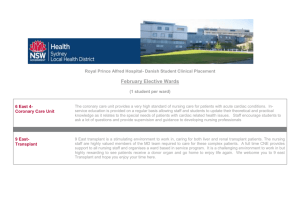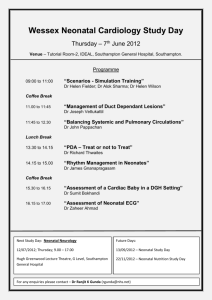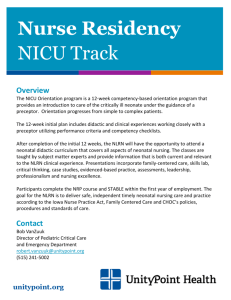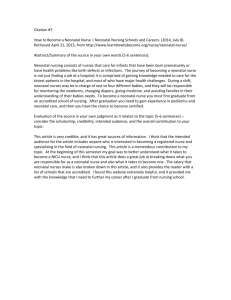ARCHIVES OF DISEASE IN CHILDHOOD (FETAL & NEONATAL EDITION)
advertisement
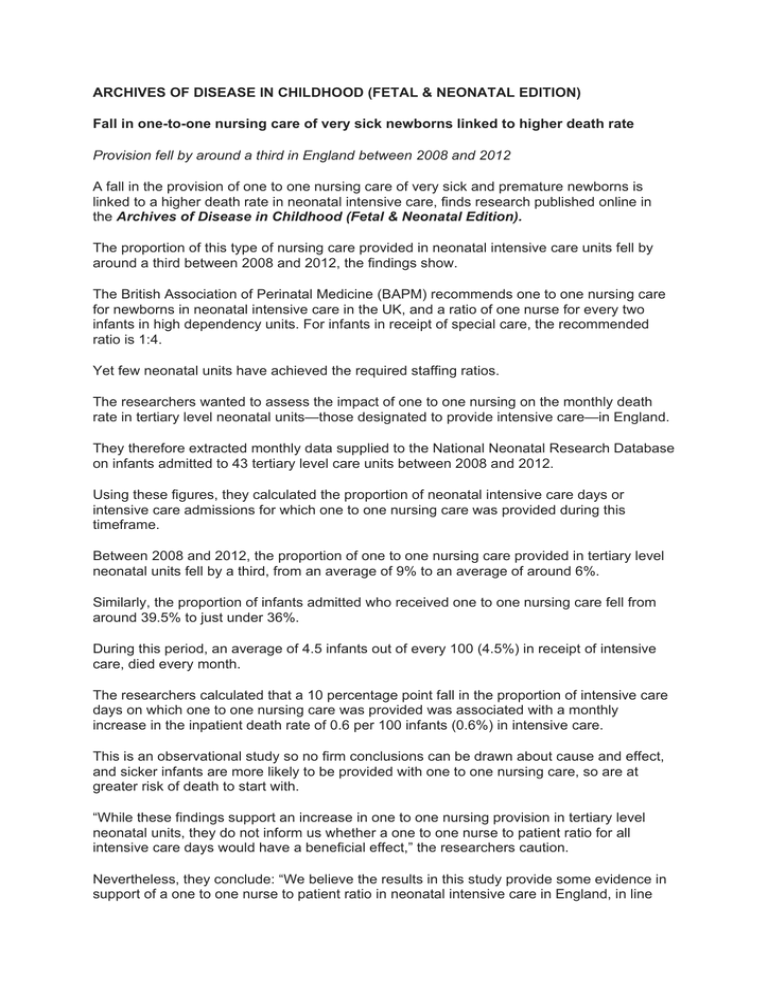
ARCHIVES OF DISEASE IN CHILDHOOD (FETAL & NEONATAL EDITION) Fall in one-to-one nursing care of very sick newborns linked to higher death rate Provision fell by around a third in England between 2008 and 2012 A fall in the provision of one to one nursing care of very sick and premature newborns is linked to a higher death rate in neonatal intensive care, finds research published online in the Archives of Disease in Childhood (Fetal & Neonatal Edition). The proportion of this type of nursing care provided in neonatal intensive care units fell by around a third between 2008 and 2012, the findings show. The British Association of Perinatal Medicine (BAPM) recommends one to one nursing care for newborns in neonatal intensive care in the UK, and a ratio of one nurse for every two infants in high dependency units. For infants in receipt of special care, the recommended ratio is 1:4. Yet few neonatal units have achieved the required staffing ratios. The researchers wanted to assess the impact of one to one nursing on the monthly death rate in tertiary level neonatal units—those designated to provide intensive care—in England. They therefore extracted monthly data supplied to the National Neonatal Research Database on infants admitted to 43 tertiary level care units between 2008 and 2012. Using these figures, they calculated the proportion of neonatal intensive care days or intensive care admissions for which one to one nursing care was provided during this timeframe. Between 2008 and 2012, the proportion of one to one nursing care provided in tertiary level neonatal units fell by a third, from an average of 9% to an average of around 6%. Similarly, the proportion of infants admitted who received one to one nursing care fell from around 39.5% to just under 36%. During this period, an average of 4.5 infants out of every 100 (4.5%) in receipt of intensive care, died every month. The researchers calculated that a 10 percentage point fall in the proportion of intensive care days on which one to one nursing care was provided was associated with a monthly increase in the inpatient death rate of 0.6 per 100 infants (0.6%) in intensive care. This is an observational study so no firm conclusions can be drawn about cause and effect, and sicker infants are more likely to be provided with one to one nursing care, so are at greater risk of death to start with. “While these findings support an increase in one to one nursing provision in tertiary level neonatal units, they do not inform us whether a one to one nurse to patient ratio for all intensive care days would have a beneficial effect,” the researchers caution. Nevertheless, they conclude: “We believe the results in this study provide some evidence in support of a one to one nurse to patient ratio in neonatal intensive care in England, in line with BAPM guidelines, and therefore provide increased nursing labour provision on neonatal units in England.” In a linked editorial, Dr Alan Fenton, SueTurrill, and Caroline Davey, the chief executive of premature and sick baby charity Bliss, point out that over 90,000 babies were admitted to neonatal units in England, Scotland, and Wales in 2014: just under 14% of the care days these babies received was in intensive care. They highlight the health secretary’s ambition, announced at the end of last year, to cut the rate of stillbirths, neonatal and maternal deaths in England by 30% by 2030. Laudable though this might be, “the announcement has so far singularly failed to acknowledge the importance of improving staffing levels in order to reduce neonatal deaths, despite consistent information from neonatal professionals,” they write. And recent government policy may worsen shortages, they suggest. “While the Secretary of State has acknowledged the mistake made by the coalition government in 2010, in cutting the number of student nurse places commissioned, it is still far from clear whether the government’s plans to replace student nurse bursaries with loans, as outlined in the 2015 Comprehensive Spending Review, will have the desired effect of increasing the number of nurses trained, or will just put a barrier in the way of those who wish to join the profession,” they conclude.

